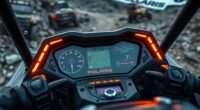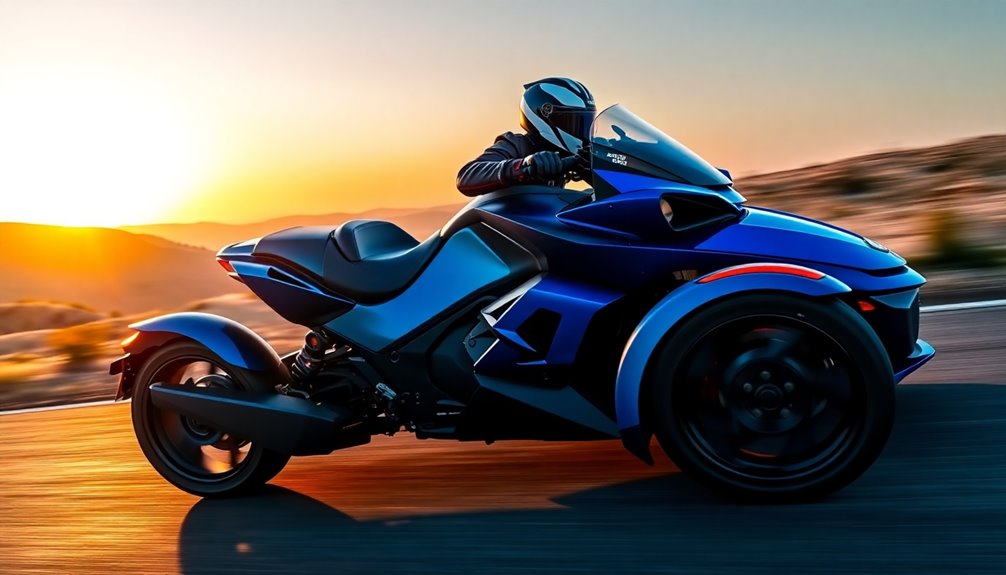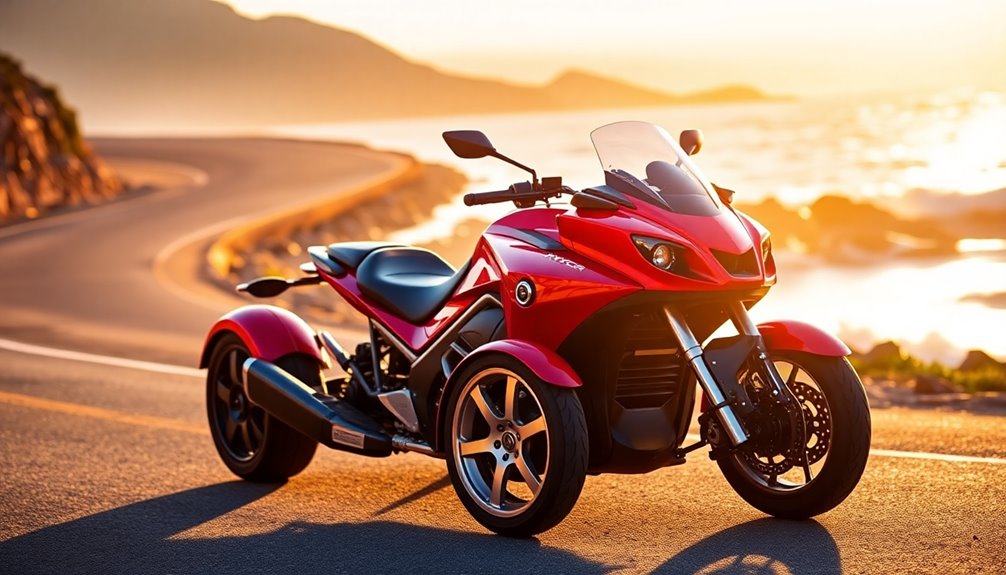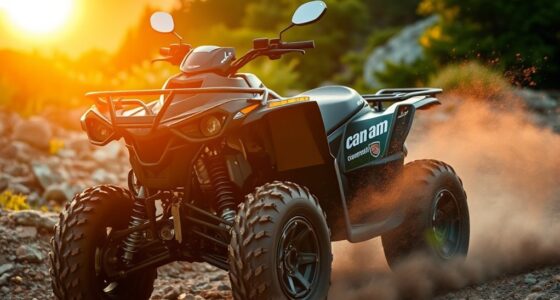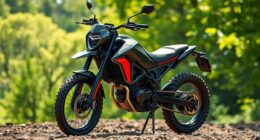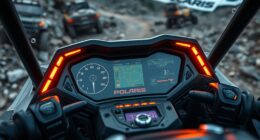Can-Am’s off-road design process emphasizes ergonomic layouts that guarantee comfort, control, and reduced fatigue. They select strong, lightweight materials like composites and aluminum for durability and performance. Rigorous testing, including computer simulations and real-world stress analysis, helps improve resilience and reliability. The process also focuses on easy maintenance and high assembly standards to ensure long-term dependability. If you want to discover how they combine science and innovation for top-tier off-road vehicles, keep exploring the details.
Key Takeaways
- Can-Am employs advanced computer modeling to simulate real-world off-road stresses on vehicle components.
- They prioritize ergonomic cockpit layouts for driver comfort and enhanced control during challenging terrains.
- Material selection focuses on durable, lightweight plastics, composites, and high-strength metals to withstand harsh conditions.
- Rigorous testing validates design choices, ensuring durability, resilience, and long-term reliability of parts.
- Manufacturing emphasizes corrosion resistance, easy maintenance, and strict assembly standards for sustained off-road performance.
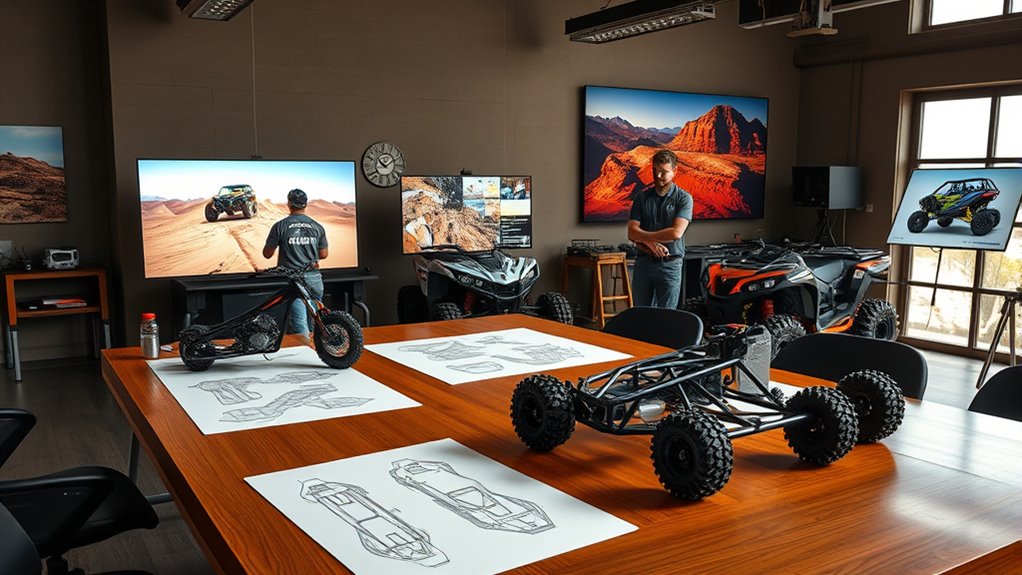
Have you ever wondered how Can-Am designs its off-road vehicles to deliver top performance and durability? The answer lies in their meticulous design process, where every detail is crafted to optimize your experience and guarantee longevity. At the core of this process is a deep focus on vehicle ergonomics. Can-Am engineers study how drivers interact with their machines, analyzing seating positions, control placements, and visibility to create a cockpit that feels intuitive and comfortable. They understand that a well-designed ergonomic layout reduces fatigue during long rides and enhances control, giving you confidence on challenging terrains.
Can-Am prioritizes ergonomic design for comfort, control, and confidence on challenging terrains.
Material selection plays an essential role as well. Can-Am’s team carefully chooses materials that balance strength, weight, and resistance to harsh environments. For example, they select durable plastics and composites for body panels that resist impacts, scratches, and UV damage, ensuring your vehicle maintains its sleek look over time. The chassis components are crafted from high-strength steel or aluminum alloys, providing the necessary rigidity without adding unnecessary weight. This thoughtful material choice not only boosts performance but also guarantees the vehicle can withstand rough off-road conditions, from rocky trails to muddy fields.
Designing for durability isn’t just about the materials; it’s about how they’re integrated. Can-Am’s engineers use advanced computer modeling and testing to simulate real-world stresses on every part of the vehicle. They analyze how different materials perform under loads, vibrations, and temperature fluctuations, making adjustments to improve resilience. This rigorous approach ensures that each component, whether it’s the suspension arms or the frame, can endure the demands of off-road adventures without failure. Additionally, incorporating evidence-based techniques helps optimize the balance between performance and longevity, ensuring the vehicle remains reliable over time.
Furthermore, the design process emphasizes reducing maintenance needs and simplifying repairs. By selecting corrosion-resistant materials and designing components that are easy to access, Can-Am makes sure your vehicle stays reliable with minimal fuss. The focus on quality and precision during assembly guarantees that each vehicle meets strict standards for performance and safety right out of the factory.
Frequently Asked Questions
How Does Customer Feedback Influence Design Changes?
Customer input plays a crucial role in shaping design changes by guiding the design iteration process. You provide feedback based on your riding experiences, highlighting what works well and what needs improvement. This input helps the design team refine features, enhance performance, and address issues more effectively. As a result, your feedback directly influences the evolution of off-road vehicles, ensuring they meet your needs and expectations better with each new iteration.
What Materials Are Prioritized for Durability?
Think of your off-road vehicle as a sturdy bridge—materials need to withstand constant stress. You prioritize high-strength aluminum and reinforced plastics for durability factors, ensuring longevity and resilience. Material selection focuses on impact resistance and fatigue strength, much like a bridge’s support beams. These choices keep your Can-Am reliable, even in tough terrains, so you can push limits without worry, knowing your ride’s built to last.
How Are Safety Standards Integrated Into Design?
You incorporate safety standards into the design by strictly following safety protocols and ensuring regulatory compliance. From the start, you evaluate potential risks and embed features like reinforced structures and protective barriers to enhance rider safety. You also collaborate with safety experts and adhere to industry regulations, testing prototypes rigorously to meet or exceed safety requirements. This proactive approach guarantees that safety remains a core priority throughout the entire design process.
What Testing Methods Are Used During Development?
During development, you use aero testing to evaluate airflow and improve vehicle stability, ensuring ideal performance. You also conduct ergonomic assessments to make sure the design fits user comfort and safety. These testing methods help identify potential issues early, allowing you to refine the vehicle’s design. By combining aero testing and ergonomic assessments, you create off-road vehicles that are both durable and user-friendly, meeting high safety and quality standards.
How Does Environmental Impact Shape Design Decisions?
Think of the Earth as your loyal companion, guiding your decisions. You prioritize sustainability practices and eco-friendly materials, knowing they reduce environmental impact. This shapes your design choices, ensuring vehicles minimize emissions and preserve natural resources. By integrating these principles, you create off-road machines that respect the environment while delivering performance. Your commitment fuels innovation, proving that responsible design can be powerful and inspiring, just like the enduring spirit of adventure.
Conclusion
Understanding Can-Am’s off-road design process is like peeling back the layers of a complex puzzle. You see how each piece, from engineering to testing, fits together to create machines built for adventure. By paying close attention to detail and pushing boundaries, Can-Am crafts vehicles that conquer the toughest terrains. So, next time you hit the trail, remember it’s more than just a ride — it’s a symphony of innovation working in harmony beneath you.

